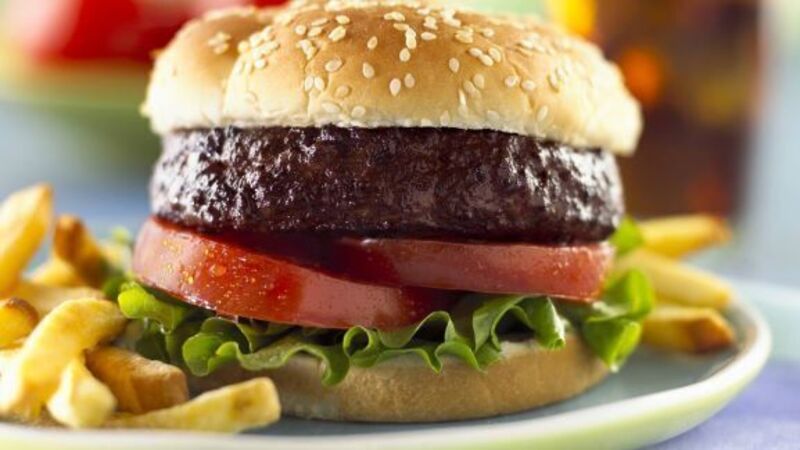Basic Beefburgers

Unfortunately it is unlikely to be the last such incident, now that we have virtually handed over control of what we eat to the multinationals.
Understandably their primary concern is to their shareholders rather than the health of the nation, so the downward pressure on prices continues.
Food could be as cheap as we like it to be if there wasn’t such ludicrous amount of waste in every stage from the field to the fork.
Everyone deserves to have access to nourishing wholesome food.
This challenge creates a terrible dilemma; food must be affordable for everyone so the downward pressure on prices is relentless.
Animals, plants and fish are being produced ever more intensively.
Processors are being challenged to produce ‘food’ ever more cheaply but beyond a certain point it simply cannot be done without resorting to totally unacceptable practices.
The cost in health terms and socioeconomic terms is incalculable.
Take, for example, the 20 cent burger so much in recent news.
Out of that 20 cent, 30+% goes to the retailer, 20% goes to the distributor, so now we are down to 10 cent.
The manufacturer’s costs must come off that, food cost, labour, packaging, insurance … so we’re lucky if the value of the meat in the burger is as much as five cent.!
In the midst of all the furore, I telephoned my local butcher and asked how much a kilo of mince from the cheapest cuts — say brisket, beef cheek, shin — would cost with a nice proportion of beef fat to make it succulent and juicy. The answer was €7.50 a kilo.
Out of that, I could make 10 tasty wholesome burgers but the meat cost alone would be 75 cent each.
Some good burgers would realistically cost about €1.50 to produce, so how can one possibly produce eight burgers for €1.50 — well now we know.
There’s a huge difference in price and one that impacts significantly on a cash-strapped family.
I certainly don’t have a magic bullet but this much I do know — it’s much easier if you are fortunate enough to be able to cook and have the almost forgotten skills of how to turn fresh inexpensive ingredients into a decent nourishing meal.
Every week from now on I will do a recipe to feed four people for a maximum of €5.50.
This is a gem of a recipe which can be made in seconds and used for breakfast or as a pudding or just to go with a cup of tea.
There are many variations on the theme, they can have sweet or savoury fillings and the ingredients for the batter only cost a few cents.
Popovers can also be cooked in a six- or seven-inch sponge cake tin until crisp and bubbly, then filled with a salad or anything you fancy.
4 ozs (110g) flour
2 free range eggs
10 fl ozs (½ pint/300ml) whole milk
1/2 ozs (15g/ 1/8 stick) butter, melted
Icing sugar, to dust
Filling
½ pot homemade raspberry or blackcurrant jam
5 fl ozs (¼ pint/150ml/generous ½ cup) cream, whipped
Sieve the flour into a bowl, make a well in the centre of the flour, drop in eggs. Using a small whisk or wooden spoon, stir continuously, gradually drawing in flour from the sides and, add the milk in a steady stream at the same time.
When all the flour has been mixed in, whisk in the remainder of the milk and cool melted butter.
Allow to stand for one hour. Grease hot deep patty tins with pure beef dripping or oil and fill half full.
Bake in a hot oven 230C/450F/regulo 8, for 20 minutes approx.
Remove from the tins. Cool and fill with a blob of homemade raspberry jam and whipped cream. Dust with icing sugar and serve immediately.
Note: If serving for breakfast, fill with a spoon full of homemade marmalade, omit the cream.
Yorkshire Pudding
Follow the above recipe, use beef dripping or olive oil to grease the tins. I sometimes put two or three stoned olives into each one.
Cheese Popovers
Add 2 ozs (50g) grated cheddar cheese and ½tsp Dijon mustard and a good pinch of salt to the mixture, season well and proceed as above, omit the jam and cream.!
After the recent revelations we scarcely need to be reminded that the secret of really good beefburgers is the quality of the mince.
Find a local butcher that you can trust.
It doesn’t need to be an expensive cut but it is essential to use the beef on the day it is minced.
A small percentage of fat in the mince will make the hamburgers sweet and juicy.
The egg is not essential, although it helps to bind the burgers and increases the food value.
Fresh herbs are a delicious addition but not essential, but seasoning is.
15g (½oz) butter
55g (2oz) onion, chopped
450g (1 lb) freshly minced beef — flank, chump or shin would be perfect
½ tsp fresh thyme leaves
½ tsp finely chopped parsley
1 small egg, beaten, free-range and organic, optional
Salt and freshly ground pepper
Oil or dripping
Melt the butter in a saucepan and toss in the chopped onion, sweat until soft but not coloured, allow to get cold.
Meanwhile mix the mince with the herbs and beaten egg, season with salt and freshly ground pepper, add the onions and mix well.
Fry off a tiny bit on the pan to check the seasoning, correct if necessary.
Then shape into hamburgers, 4-6 depending on the size you require.
Cook to your taste on a medium-hot pan or grill pan in a little oil, turning once.
Serve on or off a bun or a Bla, or even on toast with or without chips, and your favourite accompaniment, slices of cheese, maybe tomato sauce — how about making that yourself?
Tip: If the hamburgers are being cooked in batches make sure to wash and dry the pan between batches.
Reduce it a little more for pizza topping or to serve with burgers, or it may be too sloppy.
4 ozs (110g/1 cup) sliced onions
A clove of garlic, crushed (optional)
1-2 chopped fresh chillies Jalapeno, or less of Thai
1 dstsp (2 American tsp) olive oil
2 lbs (900g) very ripe tomatoes, or ½ fresh and ½ tinned
1-2 tbsp (1-2 American tbsp + 1-2 tsp) of any of the following: chopped, thyme, parsley, mint, basil, lemon balm, marjoram
Salt, freshly ground pepper and sugar to taste
Sweat the sliced onions and garlic and chilli (if used) in oil on a gentle heat. It is vital for the success of this dish that the onions are completely soft before the tomatoes are added.
Remove the hard core from the tomatoes. Put them into a deep bowl and cover them with boiling water.
Count to 10 and then pour off the water immediately; peel off the skins, slice and add to the onions. Season with salt, freshly ground pepper and sugar and add a generous sprinkling of chopped basil.
Cook for just 10-20 minutes more, or until the tomato softens. Taste, correct seasoning.
May be served immediately or reheated later.
Potato gratins are a tasty, nourishing and economical way to feed lots of hungry people on a chilly evening, This recipe could also include little pieces of a lamb chop cut into dice, so it can be a sustaining main course or a delicious accompaniment.
Streaky bacon, either smoked or unsmoked, is always good value and a terrific store cupboard staple.
Serves 4 as a main course
Serves 6 as an accompaniment if you omit the bacon.
3 lbs (1.5kg) ‘old’ potatoes, eg Golden Wonders or Kerrs Pinks
4-6ozs streaky bacon, cut into ½-inch lardons, strips
2 bunches of spring onions, use both white and green parts, OR I large onion, chopped
A knob of butter, maybe 1 oz or so,
4-6 ozs (75-175g) Irish mature Cheddar cheese, grated
salt and freshly ground pepper
½—¾ pint (300-450ml/1¼ — 2 cups) homemade chicken, beef or vegetable stock
Oval ovenproof gratin dish — 12½ inch (31.5cm) long x 2 inch (5cm) high
Preheat the oven to 200C/400F/regulo 6.
Slice the peeled potatoes thinly, about ¼ inch thick.
Put into a saucepan of cold water, bring to the boil for a minute or two, drain, refresh with cold water and drain well.
(This removes the starch.)
Trim the spring onions and chop both the green and white parts into approx ¼-inch (5mm) slices with a scissors or a knife.
If you decide to use an ordinary onion, cook it in a little melted butter for a few minutes until it softens.
Rub an oven proof dish with a little butter, scatter with some of the bacon lardons and spring onions, then a layer of potatoes and some grated cheese. Season well with salt and freshly ground pepper. Continue to build up the layers finishing with an overlapping layer of potatoes.
Pour in the boiling stock, scatter with the remaining cheese.
Bake in a preheated oven for 1-1¼ hours or until the potatoes are tender and the top is brown and crispy.
Note: It may be necessary to cover the potatoes with a paper lid for the first half of the cooking.
I found myself in Dalkey recently in need of a cup of tea and stumbled upon the Tramyard — apart from a really good cup of tea in the cute café and a slice of barmbrack there were several other little shops in individual timber beach huts across the cobbled yard and a BB grill which seems to be swinging into action.
Knockdrinna Farm Shop: not sure if you know about this little gem in the little village of Stoneyford in Co Kilkenny. Coming from Dublin you’ll need to swing off the road at Junction 9. It’s on the main street — a little farm shop with a tiny café behind. Here multi award-winning cheesemaker, Helen Finnegan makes cows, goats’ and sheeps’ milk cheese. Tel: 056-7728446.
Sandbrook House Bed & Breakfast in County Carlow is close by, just the kind of comfy country house where you can curl up in a deep sofa in front of a roaring fire to read a good book and forget about the winter blues. Tel: 059 915 9247 or www.sandbrook.ie.
The Coal Quay Farmers Market on Saturday morning is one of Cork’s best kept secrets, check it out once and I guarantee it’ll become a weekly habit, check out Caroline Robinson’s stall.















